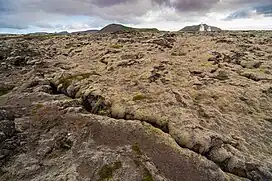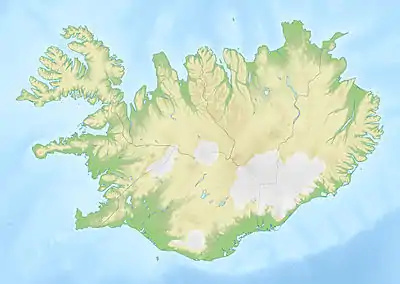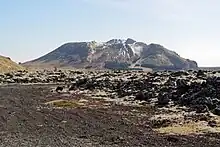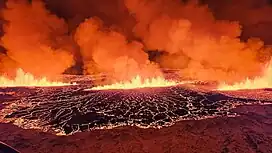| Eldvörp–Svartsengi | |
|---|---|
 Svartsengi in August 2004 | |
| Highest point | |
| Elevation | 243 m (797 ft)[1] |
| Coordinates | 63°51′50″N 22°26′20″W / 63.86389°N 22.43889°W[1] |
| Naming | |
| English translation | fire cones–black meadow |
| Language of name | Icelandic |
| Geography | |
 Eldvörp–Svartsengi | |
| Geology | |
| Mountain type | Volcanic system |
| Last eruption | 2023 |
Eldvörp–Svartsengi (Icelandic pronunciation: [ˈɛltvœr̥p–ˈsvar̥(t)sˌeiɲcɪ]); "fire cones–black meadow" in Icelandic also Svartsengi volcanic system) is a volcanic system in the southwest of Iceland on the Southern Peninsula, southeast of Keflavík International Airport and north of the town of Grindavík. Made up of fissures, cones and volcanic craters, it had been relatively inactive for several centuries until 2020, 2022 and 2023 when seismic activity occurred in connection with nearby Fagradalsfjall eruptions. Then the system itself erupted in December 2023.
Geography
Location

Eldvörp–Svartsengi is located in the southwest of Iceland, in the west of the Southern Peninsula, which forms the southwest tip of the country.[1]
The Icelandic toponym Svartsengi, literally "black meadow", designates a small valley at the foot of Sýlingarfell. From here, Keflavík and its eponymous international airport are 15 km (9.3 mi) to the northwest, the port town of Vogar is 11 km (6.8 mi) to the north, the port town of Grindavík is 4 km (2.5 mi) to the south, and the cape Reykjanes 16 km (9.9 mi) to the southwest. Reykjavik, the national capital, is about 30 km (19 mi) to the northeast.[1] The Svartsengi Power Station and the Blue Lagoon, served by routes 43 and 426, are located on the volcanic system. At the top of Þorbjörn, the highest point of the Svartsengi, there are relay antennas; and to the south, on the edge of the volcano, stand the antennas of the Naval Radio Transmitter Facility Grindavik.
The majority of Svartsengi is located in the municipality of Grindavíkurbær, with the exception of the northeastern end of the fissures which are found in that of Vogar, both in the region of Suðurnes.[1]
Geology
Lacking a central volcanic cone, the Svartsengi volcanic system consists of a set of fissures, cones and volcanic craters aligned over 30 km (19 mi) in length and 7 km (4.3 mi) in width, oriented north-east to south-west and surrounded by fields of lava:[2] Þorbjörn (243 m (797 ft)), Sýlingarfell (206 m (676 ft)), Stóra-Skógfell (188 m (617 ft)) and Litla-Skógfell (85 m (279 ft)) as noted from the southwest to the northeast.[1] Two other volcanic systems surround Svartsengi, namely Reykjanes to the west and Fagradalsfjall to the east,[1] both also consisting of a set of fissures, cones and craters oriented in a parallel manner.[2] Thus, although they have similar geological and topographical characteristics, and function on the same tectonic principle in a rift context, they also possess notable differences in the geochemical composition of their lavas, and also a certain individuality in their topography and location, which has tended volcanologists to consider them with time as systems distinct from each other.[2][3]: 30 Together with Reykjanes, Fagradalsfjall, Krýsuvík and Brennisteinsfjöll, Svartsengi is part of the Reykjanes volcanic belt.
The lavas emitted by the Svartsengi are exclusively basalts -- notably picrite and tholeite -- and emerge through effusive eruptions with a volcanic explosivity index of 1 to 3, which produce lava flows and limited projections of tephras.[2]
History
%252C_Reykjanes_peninsula.JPG.webp)
During the Holocene, the Svartsengi experienced between twelve and fifteen eruptive periods – a periodicity of approximately 1,000 years – as evidenced by the lava flows associated with it.[2] These recurring activities are represented by a close succession of eruptions over a period of several decades.[2] The last of these eruptions took place in the 13th century with the "Reykjanes fires", a series of effusive eruptions on Svartsengi and Reykjanes, which took place between 1210 and 1240 and which produced lava flows with an area of 50 km2 (19 sq mi) for Svartsengi alone.[2]
2023–2024 earthquakes and eruptions
In December 2019 volcanic activity began near the hyaloclastite mountain Þorbjörn, which indicated that the Reykjanes Peninsula was beginning a new volcanic cycle after 800 years of inactivity.[4] In the following four years, five magmatic intrusions have formed in the Eldvörp-Svartsengi volcanic system, the first four of which stalled before reaching the surface.[5] During this time volcanic unrest on the peninsula was mostly associated with the neighboring Fagradalsfjall system, where three out of four confirmed magmatic intrusions culminated in volcanic eruptions.[6][7][8][9]

On 24 October 2023, a new magmatic intrusion underneath the area caused a swarm of intense earthquakes to begin.[9] Several hundred tremors were detected daily with hypocenters between 6 and 1.5 kilometers deep, the vast majority of magnitude less than 3 but a few exceeding this value, up to 4.5 for the most powerful.[10][11] On 27 October the alert level for aviation was reassessed to yellow.[12][13] By 1 November, 10,000 tremors had already been recorded, including 26 exceeding a magnitude of 3.[10] At the same time, the ground rose by more than five centimeters, mainly at around 1.5 kilometers to the southwest of the Blue Lagoon and northwest of Þorbjörn.[10][11] These phenomena were interpreted as the intrusion of magma at a depth of four or five kilometers below the sector most affected by soil uplift.[10][11] Such events had already occurred in 2020 and 2022 in the same sector without this leading to an eruption.[11] On 9 November, seismicity reached levels close to 5 on the Richter scale, which led to the decision to close the Blue Lagoon as a precaution.[14] The frequency and intensity of the earthquakes dramatically increased on 10 November, with 20,000 tremors recorded by that time, the largest of which exceeded magnitude 5.3.
An evacuation was ordered in the town of Grindavík, which is located near the area of the seismic activity.[9] Large-scale subsidence in and around the town is reported to have caused significant damage. This was due to the movement of magma into a dike beneath the Sundhnúkur craters, which subsequently propagated southwest under the town.[15][16] From the beginning of the earthquakes until 10 November, the land at Svartsengi rose by more than 10 cm (4 in) within a span of 16 days. Following a substantial subsidence of 35 cm (14 in) on that date, a new phase of activity led to a land rise of about 30 cm (12 in) by December 8 [17] which surpassed the level that was previously reached before 10 November.
On the evening of 18 December 2023, a volcanic eruption began near Hagafell, about 4km (2.5 miles) north-east of Grindavík,[18][19] following a series of small earthquakes that began at around 21:00 local time.[20] The Icelandic Meteorological Office stated that the eruption stemmed from a fissure with a length of about 3.5 km, with lava flowing at a rate of around 100 to 200 cubic metres per second. An Icelandic Civil Defence official told RUV that the eruption had happened quickly and appeared to be "quite a large event".[21] Following an earthquake swarm warning in the early hours of the 14 January 2024, those that had returned to the town of Grindavík were re-evacuated shortly before further fissure eruptions, with lava entering the town.[22]
Activities
The proximity to the most populated cities in the country, including Reykjavik, and the significant geothermal potential of the site led to the construction of the Svartsengi Power Station, commissioned in 1977. The water discharged near the power plant was heavily loaded with minerals, most notably in silica, and formed a silty body of water in the lava field, leading eventually to the construction of the Blue Lagoon in 1992.[23] During the seismic activity of November 2023, work was begun on measures to protect the plant in case of an eruption. This included substantial protective walls and a diversionary dike.[24]
See also
References
- 1 2 3 4 5 6 7 "Visualisation". Landmælingar Íslands. 13 November 2023.
- 1 2 3 4 5 6 7 Sigurgeirsson, Magnús Á.; Sigmundur, Einarsson (2019). "Reykjanes and Svartsengi volcanic systems". Icelandic Meteorological Office, Institute of Earth Sciences at the University of Iceland, Civil Protection Department of the National Commissioner of the Iceland Police. Retrieved 2 November 2023.
- ↑ Andrésdóttir, Þóra Björg (2018). Volcanic hazard and risk assessment at Reykjanes, vulnerability of infrastructure. Masters thesis (PDF) (Thesis). University of Iceland. pp. 1–89. Retrieved 28 December 2023.
- ↑ Sigfússon, Ingólfur Bjarni; Aðalbjörnsson, Tryggvi; Sigurðardóttir, Kristín; Kolbeinsson, Jóhann Bjarni; Guðmundsson, Ingvar Haukur; Þórisson, Arnar (2023-11-21). "Hamfarir í Grindavík gætu boðað nýjan veruleika á Reykjanesskaga". Kveikur (in Icelandic). Retrieved 2023-11-23.
- ↑ "Litlar hreyfingar mælast innan sigdalsins í og við Grindavík". Veðurstofa Íslands (in Icelandic). Retrieved 2023-11-23.
- ↑ Óladóttir, Bergrún Arna; Pfeffer, Melissa Anne; Barsotti, Sara; Björnsson, Bogi Brynjar; Titos, Manuel; Gupta, Réne; Stefánsdóttir, Gerður; Tarquini, Simone; Vitturi, Mattia de' Michieli (June 2023). "Langtímahættumat fyrir Reykjanesskaga vestan Kleifarvatns" (PDF). Íslensk eldfjallasjá (in Icelandic). Retrieved 2023-11-24.
- ↑ "Catalogue of Icelandic Volcanoes - Reykjanes". Icelandic Met Office / University of Iceland / Ríkislögreglustjórinn. Archived from the original on 2 November 2023. Retrieved 2023-11-15.
- ↑ "Catalogue of Icelandic Volcanoes - Fagradalsfjall". Icelandic Met Office / University of Iceland / Ríkislögreglustjórinn. Archived from the original on 4 July 2023. Retrieved 2023-11-15.
- 1 2 3 "Magma intrusion possibly extending beneath Grindavík". Icelandic Meteorological office. Archived from the original on 11 November 2023. Retrieved 21 November 2023.
- 1 2 3 4 "Volcanic unrest continues on the Reykjanes Peninsula". Icelandic Meteorological Office. Retrieved 2 November 2023.
- 1 2 3 4 "Reykjanes: 25 October-31 October 2023". Smithsonian Institution - Global Volcanism Program. Retrieved 2 November 2023.
- ↑ "Importante activité sismique en Islande, potentiel prélude d'une nouvelle éruption volcanique". Le Figaro. 28 October 2023. Retrieved 2 November 2023.
- ↑ "Swarm of earthquakes in Iceland heralds next volcanic eruption". The Guardian. 27 October 2023. Retrieved 2 November 2023.
- ↑ Ari Páll Karlsson (9 November 2023). "Bláa lóninu lokað". ruv.is (in Icelandic). Retrieved 9 November 2023.
- ↑ Ćirić, Jelena (30 October 2023). "Land Rising Faster on Reykjanes than Before Past Eruptions". Iceland Review. Archived from the original on 4 December 2023. Retrieved 4 December 2023.
- ↑ "Svartsengi (SENG)". Veðurstofa Íslands (Icelandic Meteorological Office). Archived from the original on 25 November 2023. Retrieved 4 December 2023.
- ↑ Halldórsson, Skúli (8 December 2023). "Nærri 30 sentimetrar á mánuði". mbl.is (in Icelandic). Archived from the original on 10 December 2023. Retrieved 10 December 2023.
- ↑ "Eruption on Reykjanes Peninsula". RÚV English.
- ↑ "Volcano erupts on Iceland's Reykjanes peninsula". CNN. 2023-12-19. Retrieved 2023-12-19.
- ↑ "Iceland volcano erupts south of the capital Reykjavik following earthquake swarm". France 24. 2023-12-19. Retrieved 2023-12-19.
- ↑ "Iceland volcano erupts on Reykjanes peninsula". BBC. 2023-12-19. Retrieved 2023-12-19.
- ↑ "An eruption has started". IMO. Retrieved 14 January 2024.
- ↑ "L'Islande, Texas de la géothermie" [Iceland , the Texas of Geothermal [technology]]. usinenouvelle.com. 21 November 2013. Retrieved 2 November 2023.
- ↑ Jessica Parker; Nadeem Shad (14 November 2023). "Iceland builds wall to protect power plant from lava". BBC News. Retrieved 14 November 2023.
External links
 Media related to Svartsengi at Wikimedia Commons
Media related to Svartsengi at Wikimedia Commons